-
Paper Information
- Paper Submission
-
Journal Information
- About This Journal
- Editorial Board
- Current Issue
- Archive
- Author Guidelines
- Contact Us
American Journal of Sociological Research
p-ISSN: 2166-5443 e-ISSN: 2166-5451
2017; 7(1): 45-55
doi:10.5923/j.sociology.20170701.07

A New Trend in Urban Housing: Gated Communities in Khartoum, Sudan
1Faculty of Geographical and Environmental Sciences, University of Khartoum, Sudan
2Faculty of Architecture, University of Khartoum, Sudan
Correspondence to: Yasin Elhadary, Faculty of Geographical and Environmental Sciences, University of Khartoum, Sudan.
| Email: |  |
Copyright © 2017 Scientific & Academic Publishing. All Rights Reserved.
This work is licensed under the Creative Commons Attribution International License (CC BY).
http://creativecommons.org/licenses/by/4.0/

Gated communities have spread extensively in both developed and undeveloped countries. Yet they have become an issue of concern among researchers and decision makers during the last three decades. The appearance of gated communities in Sudan goes back to the year 2003. Since then they have developed more rapidly and immediately they covered almost twenty sites in Khartoum, the capital of Sudan. The purpose of this paper is to trace the development of gated communities in Khartoum and investigate its suitability and sustainability for urban housing. The overall objective of this study is to reveal the major driving force behind the spread of gated communities in a country like Sudan, where independent residential units and flat houses were the dominant character in the past. A case study approach has been adopted and both primary and secondary data were applied to accomplish the aims of this study. The paper has come out with that seeking for better basic services and feeling the sense of prestige have forced wealthy people to prefer living in gated communities. Not denying the role of security in such choice, but the social tie of the Sudanese community and the special nature of gated communities make it just a sense rather than anything else. Moreover, having gated communities in a country where almost half of its population is living under the poverty line have affected negatively on the social fabric of Sudanese community. Hiding behind the wall implies that outside is not safe and lack of better amenities. The paper also showed that the sustainability of gated communities in Sudan is in danger. This due to the facts that gated communities have been developed by the private sector as a matter of investment and business rather than respond to the real need for housing. Therefore, most of the Sudanese, especially the youth do not consider gated communities as suitable housing for their lifestyle, needs and wants. Planners should carefully consider the demand for the real type housing and have to formulate regulations to avoid the negative consequences if people prefer gated housing. The paper has contributed to the ongoing debate on urban housing and open rooms for more research on gated communities, particularly in Sudan, where there is a lack of literature on such subject.
Keywords: Gated communities, Housing, Segregation, Urbanization, Sustainability, Khartoum, Sudan
Cite this paper: Yasin Elhadary, Shereen Ali, A New Trend in Urban Housing: Gated Communities in Khartoum, Sudan, American Journal of Sociological Research, Vol. 7 No. 1, 2017, pp. 45-55. doi: 10.5923/j.sociology.20170701.07.
Article Outline
1. Introduction
- In the last few decades, gated communities (GC) have become an issue of concern among researchers and policy makers worldwide. Two major schools have dominated the debate: those who view them as symptomatic of the imminent breaking down of society at large, and those who consider gated communities as innovative and efficient way of organizing and (re)distributing public goods (Pow, 2009). The notion of gated communities is not new, some traditional city or castles in the ancient history used to be surrounded by walls and a number of secured gates for defensive and security reasons (Al Shawish, 2015). Recently such an ancient urban type have slightly modified and began to re-emerge in modern settlements all over the world (Landman, 2000; Al Shawish, 2015). Despite its wide spread, gated communities don't receive attention it deserves particularly from social science until recently. According to (Roitman, 2010) only in the 1990s the growth of gated communities have become one of the interested issues for the scholars from economic and social sciences background.Several definitions have been developed to explain the concept of gated or walled communities. Grant and Mittelsteadt (2004), suggested another definition for gated communities as “a residential development on private enclosed roads from general traffic by gates across primary accesses. Fences, walls, or other natural barriers may surround the development that further limits public access”. In Fortress America, the first book on gated communities, Blakely and Snyder (1997) explain gated communities are residential areas with restricted access in which normally public spaces are privatized. While Vasselinov and Goix (2012) mentioned that gated housing communities are residential, enclaves walled or fenced and secured with both gates and security personnel. Most of the available definitions agreed upon that gated communities are characterized by having the following: security measures (cameras), controlled or restricted entrances for outsiders (walls or fences), pay regular compulsory maintenance fees and inhabitants share some socioeconomic similarities. Moreover, they have a private governing body that enforces internal rules concerning behavior and construction (Roitman, 2008). The above mentioned characteristics of gated communities worldwide are not much differ from the type of gated housing in Sudan.Not until the latter half of the nineteenth century did the first purely residential gated neighborhoods appear. The first gated communities in the world are said to have been developed in the Victorian age in England (Grant, 2005) and then moved to the United States of America at the beginning of the nineteenth century and have remained popular there since that time (Rosen and Grant, 2010). Gated developments like New York's Tuxedo Park and the private streets of St. Louis were built in the late 1800s by wealthy citizens to insulate themselves from the troublesome aspects of rapidly industrializing cities (Blakely and Snyder, 1997) but it remains rarities over there until the advent of the master-planned retirement developments of the late 1960s and 1970s. this idea supported recently by El-Ekhteyar and Furlan (2016) who stated that modern walled communities remerged in the 1980s in several world-wide cities as forms of residential accommodation. Currently, gated communities have been found everywhere and covered both developed and undeveloped countries (reputation). It is not surprising to have gated communities in developed countries where security and prestige are targeted, but to have it in a country like Sudan, a phenomenon deserves to be looked at. Several drivers have been quoted in the literature behind the wide spread of gated housing and it varies from country to others. Major among these are the security and prestige (Jeffrey et al., 2012; Obeng-Odoom et al, 2014). In multi culture countries like South Africa gated communities are a wise choice to escape crimes and risky urban environment (Touman, 2002). In some parts of the USA, Gated communities are designed mainly for the urban elite (Blakely & Snyder, 1997). While in Europe, the primary reason for gated communities is the seasonal use of houses in coastal zones. In some cities like London and Amsterdam, they have become a fashionable trend (Ajibola, Oloke, & Ogungbemi, 2011). Practicing the same lifestyle found in the home countries is another driver found is some Arab countries. In a country like Saudi Arabia foreign expatriates whose residence is part of their work contract prefer gated communities so they can freely practice their daily activities, which are prohibited outside the gates as it contradict the local traditions and against the Islamic laws (Touman, 2002). Moreover, Blakely and Snyder (1999) differentiate between three categories of gated communities: lifestyle communities, prestige communities and security zone communities. In a state like Sudan, security matter seems not to be the major reason behind the popularity of gated communities in Khartoum. So, why gated communities are there and why some people, mainly Sudanese prefer living in such compound?In a country like Sudan, where almost half of its population is living in poverty (Elhadary and Samat, 2011; 2012) having gated communities is questionable. A country like Sudan must concentrate on providing affordable houses to middle and less income instead of encouraging gated housing. Therefore, it is valuable to look deeply at the drivers behind having gated communities in Sudan, where this current phenomenon is relatively understudied. The appearance of gated communities in Khartoum goes back to the year 2003. The Alyasmine (2003) and Elnasr (2004) were the first gated communities in Sudan. Then the idea started to flourish in the inner city and now covered almost twenty sites in Khartoum (Table 1).
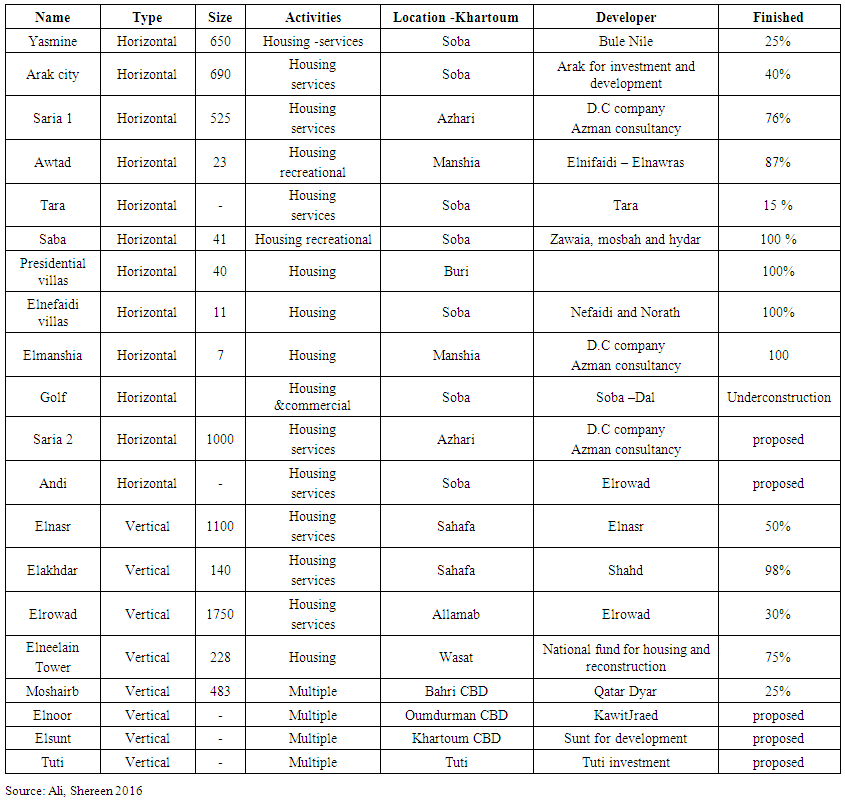 | Table 1. Gated Communities in Khartoum |
2. Methodology and Data Collection
- As stated in the above section, the lack of specific literature written on gated communities in Khartoum required the paper to rely heavily on fieldwork. This limitation coupled with the complexity of the nature of gated issue led the authors to adopt a case study approach. The approach is widely used in social sciences especially when deep analysis is needed for specific current issue. According to Yin (1984; 2014), a case study is an empirical inquiry that investigates a contemporary phenomenon (the case) to generate an in-depth, multi-faceted understanding of a complex issue in its real-life. The approach is very useful when research questions start with what, how why. This approach selects a small geographical area with a very limited number of individuals as the subjects of study; here in this paper is Elnasr gated communities (Zainal, 2007). The paper selected Elnasr housing as a case study and applied all methods related to such techniques like questionnaire, interview with the key format (planners, engineers, investors, and funders), walk through, observations and taking some photos. Not only that, the paper used secondary sources such as books, references and papers published to enrich the literature on gated communities. These further have been enhanced by the experiences of the authors. Elnsasr has been selected as a case study because it is an older type of gated communities in Khartoum. Half of its 1100 units have been finished and occupied by both domestic and foreign residents. In addition to that, the entire inhabitants expressed their willingness to participate in the Study. These justifications are enough to reject other gated houses and make Elnasr as a model to be used for further research.Technically, the fieldwork divided into two stages: the first stage is to get general information about the main characteristics of all gated houses located in Khartoum and then select the suitable one for the case study. In the second stage, all methods related to case study have been adopted and implemented in Elnasr gated communities. Twenty-five respondents have deeply interviewed, including the consultant, permanent engineer, three persons responsible for management, and security matter. The rest covered owners and renters, youth and old, male and female, people from various economic activities: private or government employees.It is important to note that the case study approach is useful in evaluating specific private or government programs. According to Yin (2003) the common use of the case study research methodology is the “evaluation” of businesses and government programs with the goal of identifying potential explanations for their successes or failures. In this regard, the study formulates a frame to evaluate the satisfaction among the people living in Elnasr gated community. The outcome of such frame gives a clear idea about its sustainability and predicts the future of a gated housing in Khartoum. The frame consists of seven measures, including location and general planning, infrastructure, social services, facilities, environment, social relation, economic aspect. Each measure breaks into several questions and assigns points for each answer, which is eighty-five in total. This figure has been classified into 5 point Likert Scale organized as follows: median, less fair, fair, good and excellent. If it ranges between 40 -50 is “medium”; between 50-60 “less fair”; between 60-70 is “fair” between 70 -80 is “good” and above 80 is an excellent.Geographical set-up of Elnasr Gated communitiesBased on the characteristics mentioned earlier, Elnasr is a typical example of gated communities located in Khartoum. It has been surrounded by a wall with main entrances controlled by guards and surveillance cameras; the access is limited to residents and to some extents to their visitors only. Elnasr Housing and Reconstruction Company have established it in 2004 in Almamrat party facing African Street and not far from Afra: the big Mall over there (Figure 1 – Figure 2). It covered around 7200 square meters with at least five-kilo meters away from the Khartoum center. It has 34 towers with almost five floors in addition to the ground floor. The compound has six gates only two are functioning the rest are completely closed. The building is surrounded by iron siege that cannot fully protect the outsiders’ eyes. It has been divided in apartment with its different size ranges between 100 – 200 square meters. Elnasr is composed of 1100 united, half of it is completely finished and occupied by the inhabitants. It also includes a number of amenities that are better off than what is usually available in the outside compounds. The provided amenities are namely: Swimming pool, two gyms, recreational club, playground, female and male hairdresser salons, supermarkets, a mosque, and at least one parking for each apartment.
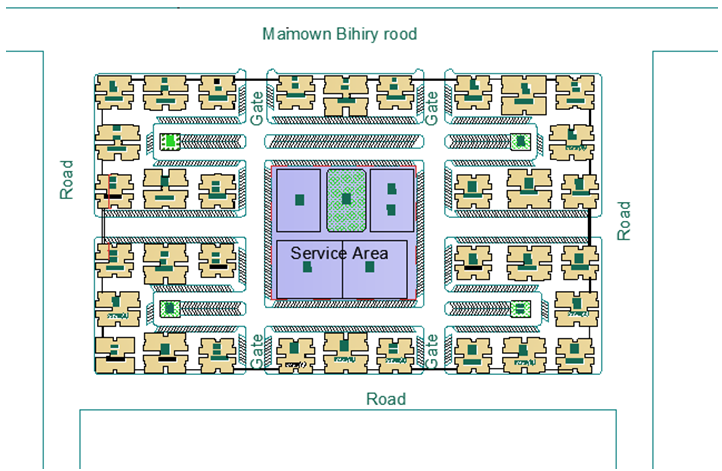 | Figure 1. Elnasr Gated Communities |
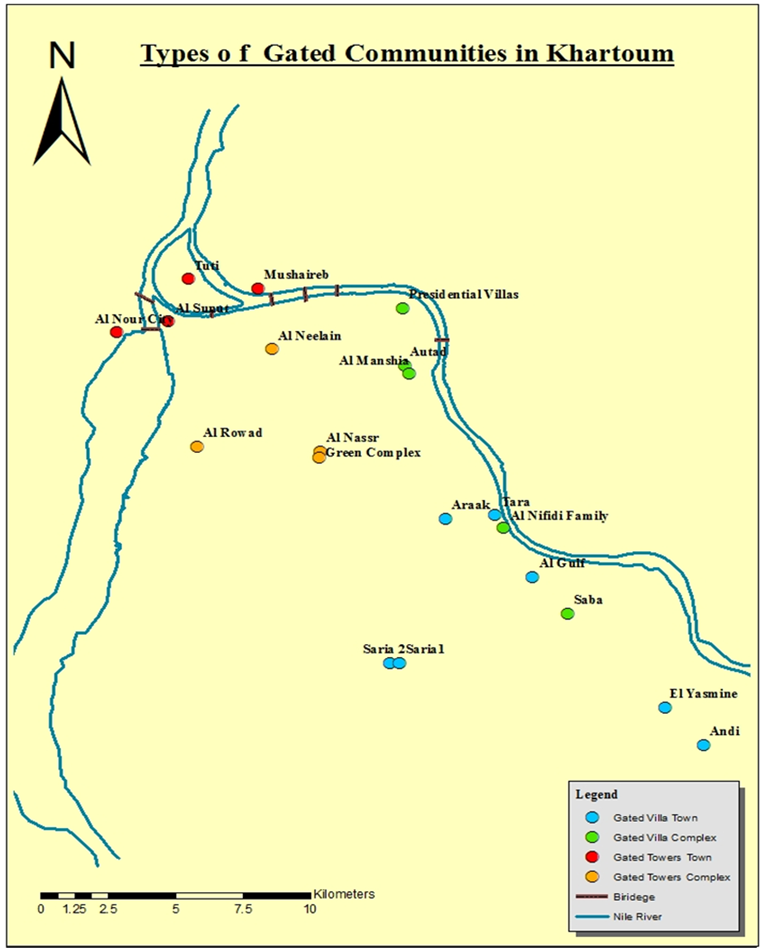 | Figure 2. Location and types of gated communities in Khartoum |
3. Result and Discussion
- As indicated in the first section that this paper is not with or against gated communities instead is going to reflect the reality. Gated communities in Khartoum have some advantages, especially when it comes to the provision of social services and security. It solved the problem of housing for a number of specific social groups living in urban areas. This benefit will be much higher if the compound located a bit far from the centre or on the fringe of urban space. Unfortunately, this location has impacted negatively on the urban land use and creates several challenges to the planners. People surrounded or living outside the compound have faced some difficulty in accessing some services due to inability to pass by the compound. The location of Elnasr and the rest of other gated communities in Khartoumdivided the city into pieces that seem independent from each other. Concerning this (Ajibola, Oloke, & Ogungbemi, 2011) stated that the rise of gated communities can lead to spatial fragmentation and separation in cities. Consequently, fragmentation can cause the city to be not a whole anymore; or a city anymore. With regard to cost benefit analysis, the area occupied by Elnasr gated communities if used by other land use purposes the gained might be higher than constructing gated communities. Economically, no one going to deny the role of gated communities in providing profit to the investors as well as revenue (tax) to the local authorities and generates more jobs to the local people. Our observation has shown that several people have benefited from the development of the gated community. On the other hand, the high payment of the apartment with the monthly fees for the basic services and maintenances affected the economic condition of the entire inhabitant in gated communities. Such payment may eliminate the role of government and led people not to respond to the state when needed. Moreover, gated communities put much effort on local government to provide better service for those living outside the compound.Much has been said about the negative impact of gated communities on social cohesion. Several authors mentioned that gated communities usually led to the fragmentation of physical and social aspect of urban areas. The paper is not fully agreed with such conclusion, as social isolation is one of the major characteristics of urban dwellers worldwide. It seems that the social fabric o Elnasr gated communities are better than people living outside. According to some scholars, it is impossible for gated communities to detach from urban society. Amin and Graham (1999) support this position, arguing that no physically bounded community can ever completely withdraw from the city, which surrounds it. In Elnasr gated communities, people have better relationships, especially among the youth people. This group has shared some activities like sports and evening games. Also the relationship among women in the compound is even better. They meet at least once a month, especially those participate in the traditional rotating saving fund. This type of saving known locally as “Khata” fund or “Sandoq” fund. Khata fund is considered as a savers’ self-administered revolving fund in which each woman contributes an equal agreed amount of money from all members and each time one member gets the whole sum of money (Sarfa) at regular intervals (NAGWA BABIKER ABDALLA, 2009). The women, headed by the chairperson, pool the total amount collected from the members and distribute it in an agreed order. On the other hand, the appearance of gated communities generates social tensions between the entire residents and people from surrounding local areas. These conflicts relate to the closure of streets, the privatization of space and the provision of services in the area (Roitman, 2008). Hiding behind the wall gives a sense that people inside are not willing to interact with outside and the vice versa. Blakely and Snyder (1997) noted that gated communities have created a new housing option for some of us, but they have also created a new societal dilemma for all of us. Low (2003) argues that gated communities separate between ‘good’ people inside, and the ‘bad’remaining outside. Inthe line to this Lynch (2007) stated that gated communities act like borders that prevent the connection and interaction between individuals of the same society, will eventually weaken the civic bonds and sense of belonging, enhance social segregation and fragmentation, and consequently produce a highly unequal society and unhealthy neighborhoods.The application of Sustainability form in gated communityThis section is about testing the sustainability and future suitability of Elnasr gated community. As indicated in the methodology the authors formulate a form to evaluate the satisfaction of the residents and then to evaluate the future of gated communities based on the views of people living in the compound. This form has been filled with data collected directly from the residents in Elnasr during the survey. Seven measures have been used each measure is given some points based on the questions answered by the respondents. The evaluation has come with that the location and general planning acquired high points while services and facilities got the least (see the table 2). Several other measures such as social services, security and environment failed to pass while another measure like infrastructure looks better compared to other measures. This implies that people are happy with suitable location and the provision of good services in Elnasr gated communities, despite that some services like sanitation, water and electricity are linked to the whole system of Khartoum network. The inhabitants of Elnasr have solved the shortage of water and electricity privately. For example, they use private well to solve the scarcity of water and private generators to overcome the shortage in electricity. The fastest response and following up continuously made sanitation system much better compared to the other outside the compound. Our survey has shown that the compound is very clean compared to other places outside. People in Elnasr are happy with the system of cleaning and on time response to the maintenances. Regarding the outer design of Elnasr building, some people feel happy with such design. The consistency in the outer building is one of the good things different from Khartoum where each has its own design which make eye pollution. Although the specialists mentioned that the design is missing the creation, attractiveness and failed to support social cohesion as the space between the buildings is not well managed for such purpose. This implies that private developers are seeking for only profit rather than considering the needs for green spaces and suitable social environment (Ali, 2016).Regarding the economic aspect, the respondents mentioned that the price was suitable when it was sold directly from the company but today the price is shooting up. In 2004, accessing department will cost you 232 Sudanese pounds, now it is approaching almost one and half million in (2016). Despite this price, it seems that still some people prefer such place due to its vicinity to services, having a small apartment instead of flat house as was in the past will reduce the cost of cleaning in addition to the sense of security. Accordingly, several people outside have sold their houses and prefer to settle in Elnasr community. This idea is different from the views of youth as one of them said Elnasr is not my choice for the future. This section concludes that the provision of services and infrastructure in Elnasr compound are not bad compared to the rest of the city but beyond the expectation of the entire inhabitants. This appeared in the overall result of the sustainability frame as the result has shown that the overall weight slightly exceeds the median level.The above section reflected clearly the satisfaction among the residents living inside the compound, but the major question is that how outsiders and planners see the future of gated communities in Sudan? The answer needs more data and it is a room for further research.
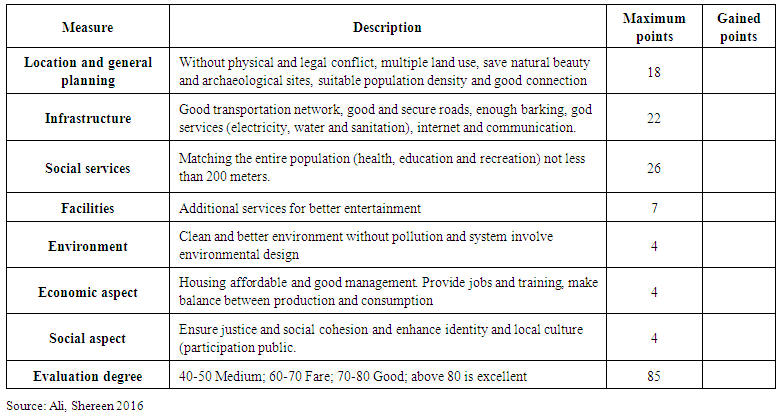 | Table 2. The Sustainability of Gated Housing |
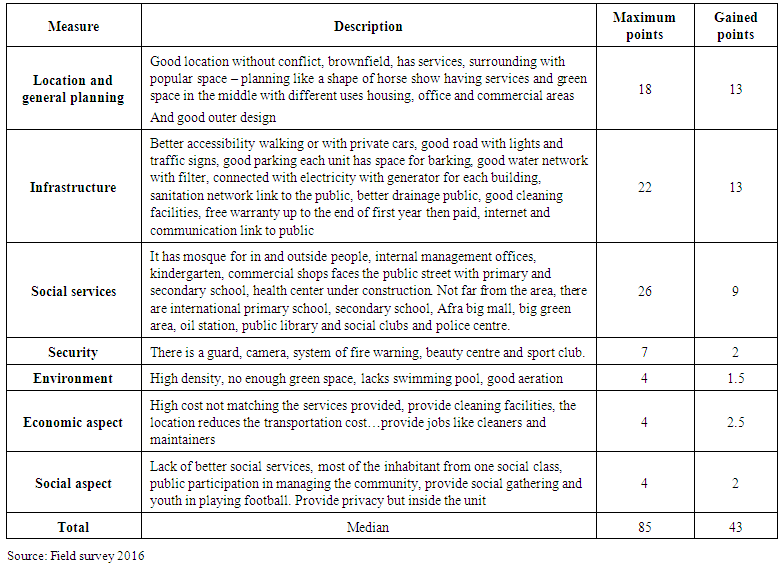 | Table 3. The Sustainability of Elnasr Gated Housing in Khartoum |
4. Conclusions
- This paper is about gated communities in Khartoum, the capital of Sudan. It shows that provision of better basic services and feeling the sense of security are some of the major drivers behind the widespread of gated phenomenon in Sudan. The paper shows that unlike gated communities worldwide, in Sudan the development of GC is more or less related to the degree of political stability and to the growth of the economy, mainly after the discovery of oil. Gated communities have introduced by private developers as a matter of business to attract expatiates and wealthy people. Currently, such business is at risk, especially after the collapse of oil due to the separation of South Sudan in the year 2011 and to the global collapse of oil prices. Further, the paper reveals that hiding behind gates end wrong signal to the outsiders and the local government. It implies that the environment (physical and social) outside the gate is not safe and the government is not shouldering its responsibility in providing better services. Gated communities has become a reality in Sudan and it becomes a choice for a number of domestic and foreign people. Thus, decision makers have to accept that and they should something to avoid its negative consequences and, above all ensure equity and access to services to all urban dwellers. The use of the sustainability model of this paper might help the planners to formulate wise policies for future urban development.
 Abstract
Abstract Reference
Reference Full-Text PDF
Full-Text PDF Full-text HTML
Full-text HTML